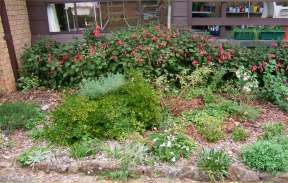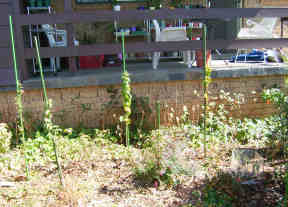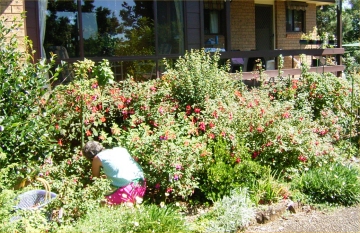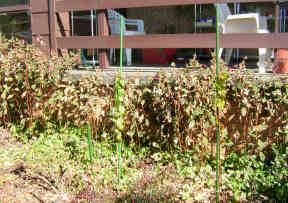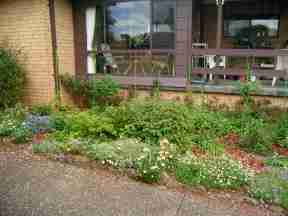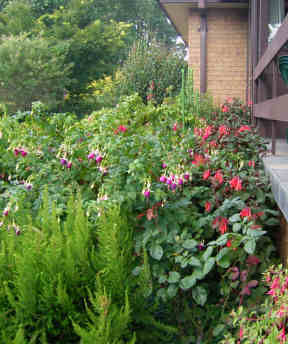Growing bush or shrub fuchsias in the ground.
See also standards and columns
·
2020 Fuchsia sale ONLY, NO open garden, click Open Fuchsia Garden for more details.
Join us on Facebook http://www.facebook.com/groups/394140627308376/
|
Pages updated Feb 2020. |
Please note I aim to grow healthy
plants with no reference to competition standards or what books say is the
“correct” method.
There are a few tricks to getting
fuchsias to grow well in the ground in our climate particularly cultivars that
are lax or trailing varieties really designed for pots or baskets. Firstly
roots have to be protected from the heat and the frost. I have planted all my
fuchsias about 1” deeper than in the pot see construction of a fuchsia garden for more
details. Then they are heavily mulched – I chose large gum tree chips about 2”
deep.
The next thing is to support the
plant until it can support itself - it is best to let the basic skeleton of the
plant become woody so it is strong enough to support the large amount of
growth. Plants grown in the ground are much larger than in containers. This can
be done with one or several short canes depending on the growth habit. If I
grow my own plants from cuttings I grow a short standard, just let the cutting
get to 4 pairs of leaves before pinching out the top pair then pinch out at every nodes twice
then the usual 2-3 node pinching (remove the first 3 sets of leaves as soon as
you have a few branches) this gives the plant a short “trunk” that can be
buried the 1” lower, then have a short stem that all the branches come from.
This trunk and one of the central branches will need to be tied to a short
stake at least until the root system develops and the main stem becomes woody.
The main reason for this is to keep
branches particularly those with bunches of flowers trailing on or near the
ground. You cannot control water to your plants (except in dry weather) so if
the mulch become saturated by rain if will be much more liable to encourage
diseases if the leaves are in contact with the mulch. This year I have had a
lot of problems with mould and rust due to a very wet humid summer and have
been able to control it better where the fuchsia foliage is well above the
mulch. If the plant has many stems or keeps sprouting from the base you will
need 4-7 short canes arranged in a sort of circular fan shape. Tie each branch
to a cane and allow each one to grow to about 8-12 inches before pinching out also shorten any side
shoots that the branches make. Pinching out makes the branch thicken as well as
producing side growth. This method works equally well with upright or trailing
plants. You will find that even quite sturdy upright growing plants will need
staking the first year or the branches will bend down under the weight of the
flowers and often break
|
The lower branches of Blush of
Dawn have been removed as they were hanging too low with at least 4 large
double blooms on each branch most of the plant was laying on the mulch. The
remaining branches have been tied to 5 bamboo stakes. Graffe Witte which is fairly lax has been tied to 5 short bamboo stakes, these don't show much as you can see even at this early stage just 3 months old. They will be removed next year once the lower branches have become woody and they can support the upper branches. A huge shrub of Ambassador that seems to thrive on heat and frost. it is about 15 years old it has a metre high woody "skeleton" that I cut back to each year |
Water tanks were essential when we were still on water restrictions. My tanks were delivered by crane. A fungi growing in a very wet November looks great but smells like rotting flesh and attracts flies. I sprayed it with fungicide as soon as it stopped raining. It is hard to see the short trunk in this photo so I have marked it with at red bracket } |
Sports
I had read about sports but never
seen one until last year when my big Pixie standard (see standards) produced a
sucker that I didn’t notice until it was about 14” long as there is a mass of
native violets around its base. It was only when it was in bud that I noticed
it and when the bud opened the corolla was purple not lilac. I immediately
investigated and it definitely was a sucker attached to the main root about 2”
below the surface with about 2” of roots on its own base. I carefully cut it off
at the point where it joined the main root system and potted it; see standards for this instant
standard method. I also cut 2 cutting from the top and potted these also. The
instant standard grew as did one of the cuttings. I thought I had a new
cultivar, a sport I decided to name after my mother Nellie Cooper who had just
died. Then came the disappointment, in a new book
there was a picture of Graffe Witte from which Pixie
was produced as a sport. If was very similar to my “new” plant, was it just a
throwback? I purchased Graffe Witte in Adelaide and
now have both plants planted close together and will see what happens. So far
my sport seems more vigorous with larger flowers and lighter foliage, but only
time will tell – when both plants have grown in the same conditions for 2-3
years I will decide if it a true sport.
|
|
|
Frost damage
As I have said we only get a few night frosts each winter but the fact
that we do get frosts governs the pruning schedule. Pruning can be done in
April so that there is time for new growth to harden off before the frost or in
late August, early September after the last frost. You will need to assess your
own situation before deciding when to prune.
Some fuchsias are more prone to frost than others, generally speaking Thryphilla fuchsias are frost tender here, and they recover
as soon as the weather warms up.
|
The Thryphilla
hedge along the side verandah
February 2006 even with a setback due to the heat everything is looking good.
March 2006 |
Even by October 2005 everything
was
|
Some
recommended fuchsias
Two
tiny pale pink single fuchsias that photographed individually look almost
identical.
They are F. magellanica
alba/molinæ and Whiteknight’s
Pearl which is double the size but still very small. They both grow in a bushy
habit and make excellent standards. I have and “Alba” that is about 3metres
high it is very heat resistance and takes some
frost. It flowers prolifically and is very vigorous easy to grow and propagate
it has much smaller flowers and smaller lighter coloured narrower leaves.
Over the years I have found that large plants of “Alba” do not transplant well
and it is best to put the plant straight from a 4” pot into the ground in its
permanent location. Also they can suddenly die for no apparent reason so best
to take cutting each year and give them to a friend if you don’t need them
yourself. They look good in all popular shapes - standard, pillar or bush and I
am trying them out as part of a hedge. Whiteknight’s
Pearl is a near relative of “Alba” and has a similar growing habit but it
is more susceptible to rust after a few attempts I have decided to only grow
Alba, a friend in Sydney has found the opposite and she only grows Alba as they
are very similar this isn't a problem. Try both and see which grows best in
your garden.
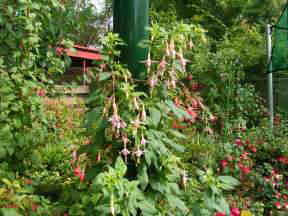
White Knight's Pearl that was trained up the base of one of the posts of the shade
sails
I would
love to hear from other Fuchsia growers; please email me at bcooper1@pacific.net.au
o Constructing
a Fuchsia Garden
o Changes to Fuchsia garden 2010 - 2012
o Growing standard and pillar Fuchsias
o Growing
Fuchsias in the ground PDF print-friendly version
o Pruning
o Where to buy Fuchsias in
Australia
§ Meetings
